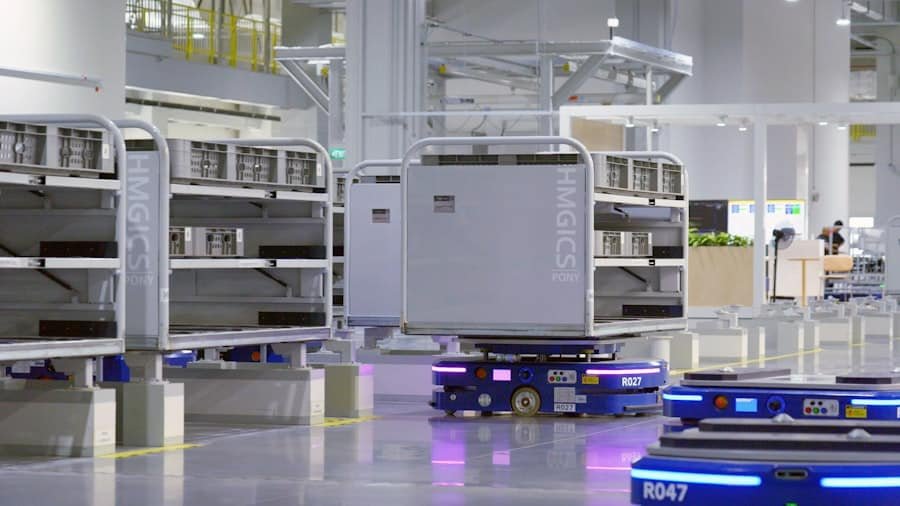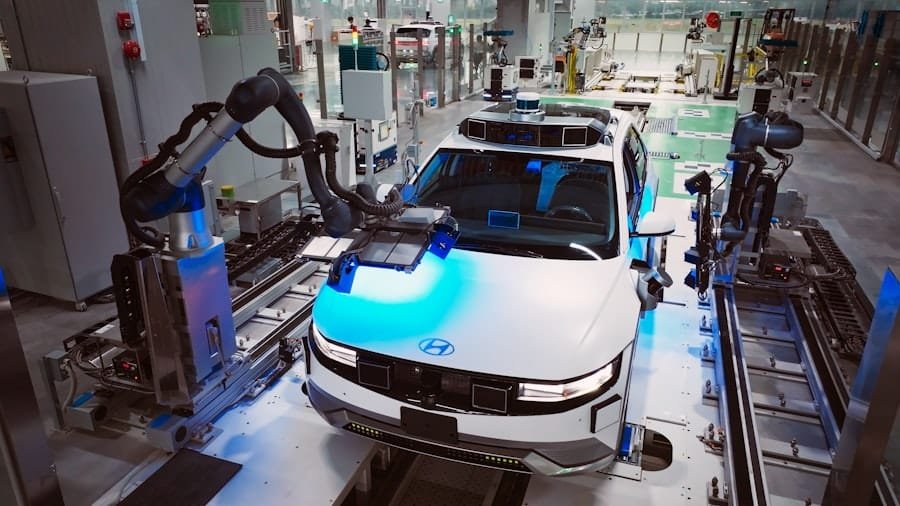Automation, the implementation of technological systems and machinery to perform tasks traditionally executed by human workers, has profoundly influenced the modern economy. Its impact spans across various sectors, from manufacturing to service industries, fundamentally altering work processes and significantly enhancing productivity and efficiency. However, the relationship between automation and wage growth remains a contentious issue, sparking extensive debate and analysis.
The potential effects of automation on wages are multifaceted. On one side, automation can potentially drive wage increases by boosting overall productivity and generating new employment opportunities in emerging fields. Conversely, it also poses the risk of displacing workers from certain roles and contributing to wage stagnation or decline in specific workforce segments.
This article will examine the complex interplay between automation and wage growth, considering various influential factors. These include the advantages and disadvantages of automation, the importance of education and skill development, the differential impacts across industries and job categories, the role of government policies and regulations, and projections for future wage trends in an increasingly automated economic landscape.
Key Takeaways
- Automation has the potential to significantly impact wage growth in various industries and job sectors.
- Pros of automation on wage growth include increased productivity and efficiency, while cons include potential job displacement and wage stagnation.
- Education and training play a crucial role in preparing the workforce for the changes brought about by automation.
- Different industries and job sectors will experience varying degrees of impact from automation, with some facing more significant changes than others.
- Government policies and regulations will need to adapt to address the challenges and opportunities presented by automation in the workforce.
- The future outlook for wage growth in the age of automation will depend on how effectively individuals, businesses, and governments navigate the changes brought about by automation.
- Navigating the effects of automation on wage growth will require a multi-faceted approach that considers the potential benefits and challenges of automation in the workforce.
The Pros and Cons of Automation on Wage Growth
Positive Effects on Wages
Automation has the potential to increase wages by boosting productivity and creating new job opportunities. By automating repetitive and mundane tasks, workers can focus on more complex and value-added activities, leading to higher productivity and ultimately higher wages. Additionally, automation can create new job opportunities in industries related to technology, engineering, and maintenance of automated systems. These jobs often require specialized skills and knowledge, leading to higher wages for those who possess them. Furthermore, automation can lead to cost savings for businesses, which can be reinvested in employee training, benefits, and higher wages.
Negative Effects on Wages
On the other hand, automation also has the potential to displace workers and lead to stagnant or declining wages for certain segments of the workforce. As machines and technology become more advanced, they can replace human workers in various tasks, leading to job displacement and unemployment. This can particularly affect low-skilled workers who are more likely to be replaced by automation.
Widening Wage Gap
Automation can lead to a widening wage gap between high-skilled and low-skilled workers, as those with specialized skills and knowledge required for operating and maintaining automated systems command higher wages, while those with less relevant skills may see their wages stagnate or decline.
The Role of Education and Training in the Face of Automation

In the face of automation, education and training play a crucial role in determining the impact on wage growth. As automation continues to transform the nature of work, there is an increasing demand for workers with specialized skills and knowledge related to technology, engineering, data analysis, and problem-solving. Workers who possess these skills are better positioned to adapt to the changing job market and command higher wages.
Therefore, investing in education and training programs that equip workers with these skills is essential for ensuring that they can thrive in the age of automation. Furthermore, continuous learning and upskilling are becoming increasingly important as automation reshapes job requirements. Workers need to be adaptable and willing to learn new skills in order to remain competitive in the labor market.
This requires a shift in mindset towards lifelong learning and a commitment to acquiring new knowledge and competencies throughout one’s career. Employers also play a crucial role in providing training and development opportunities for their employees to ensure that they can keep up with technological advancements and contribute to the success of their organizations.
The Impact of Automation on Different Industries and Job Sectors
The impact of automation on wage growth varies across different industries and job sectors. In manufacturing, automation has led to increased productivity and efficiency, which has translated into higher wages for workers involved in operating and maintaining automated systems. However, it has also led to job displacement for low-skilled workers involved in repetitive assembly line tasks.
In the service industry, automation has led to the creation of new job opportunities in areas such as data analysis, customer service, and digital marketing. These jobs often require specialized skills and knowledge, leading to higher wages for those who possess them. On the other hand, certain job sectors such as retail, transportation, and administrative support are more susceptible to job displacement due to automation.
For example, the rise of e-commerce has led to increased automation in warehousing and logistics, leading to job displacement for traditional retail workers. Similarly, advancements in autonomous vehicles have the potential to disrupt the transportation industry, leading to job displacement for truck drivers and delivery workers. Therefore, the impact of automation on wage growth is not uniform across all industries and job sectors, and it is important to consider the specific dynamics at play in each sector.
Government Policies and Regulations in Response to Automation
In response to the impact of automation on wage growth, governments have a crucial role to play in implementing policies and regulations that mitigate the negative effects of automation while maximizing its potential benefits. One approach is to invest in education and training programs that equip workers with the skills needed to thrive in the age of automation. This can include initiatives such as vocational training programs, apprenticeships, and subsidies for higher education in fields related to technology and engineering.
Additionally, governments can implement policies that support workers who are displaced by automation through retraining programs, unemployment benefits, and job placement services. This can help mitigate the negative impact on wage growth for those affected by job displacement. Furthermore, governments can incentivize businesses to invest in their workforce through tax credits for training programs and initiatives that promote lifelong learning.
On the regulatory front, governments can also play a role in ensuring that automation is implemented in a way that prioritizes worker safety and well-being. This can include regulations related to workplace safety standards, fair labor practices, and ethical considerations related to the use of artificial intelligence and robotics in the workplace.
The Future Outlook for Wage Growth in the Age of Automation

Skills in High Demand
As technology continues to advance, there will be an increasing demand for workers with specialized skills related to technology, data analysis, engineering, and problem-solving. Workers who possess these skills are likely to command higher wages as they play a crucial role in driving innovation and productivity.
Ensuring Equitable Benefits
However, there is also a need for proactive measures to ensure that the benefits of automation are shared equitably across the workforce. This includes investing in education and training programs that provide workers with the skills needed to adapt to technological advancements.
Prioritizing Worker Safety and Well-being
Implementing policies that support workers who are displaced by automation, and ensuring that automation is implemented in a way that prioritizes worker safety and well-being, are also crucial steps in this process.
Navigating the Effects of Automation on Wage Growth
In conclusion, the impact of automation on wage growth is a complex issue with both potential benefits and challenges. While automation has the potential to increase wages by boosting productivity and creating new job opportunities, it also has the potential to displace workers and lead to stagnant or declining wages for certain segments of the workforce. Education and training play a crucial role in determining the impact on wage growth by equipping workers with the skills needed to thrive in the age of automation.
Furthermore, government policies and regulations are essential for mitigating the negative effects of automation while maximizing its potential benefits. Looking ahead, proactive measures are needed to ensure that the benefits of automation are shared equitably across the workforce. By investing in education and training programs, implementing supportive policies, and prioritizing worker safety and well-being, we can navigate the effects of automation on wage growth in a way that maximizes its potential benefits while minimizing its negative impact.
If you’re interested in learning more about the impact of automation on wage growth, be sure to check out The Econosphere’s blog. They have a great article discussing how automation is affecting the labor market and what it means for workers’ wages. You can find the article here. It’s a fascinating read that delves into the complexities of this issue and offers valuable insights into the future of work.
FAQs
What is automation?
Automation refers to the use of technology and machinery to perform tasks that were previously done by humans. This can include anything from manufacturing processes to customer service interactions.
How does automation impact wage growth?
Automation can impact wage growth in several ways. On one hand, it can lead to job displacement and lower wages for workers in industries that are heavily automated. On the other hand, it can also lead to increased productivity and higher wages for workers who are able to adapt and take on more skilled roles in the workforce.
What are the potential benefits of automation on wage growth?
Automation has the potential to increase productivity and efficiency, which can lead to higher wages for workers who are able to take on more skilled roles in the workforce. It can also lead to cost savings for businesses, which could potentially be passed on to workers in the form of higher wages.
What are the potential drawbacks of automation on wage growth?
One potential drawback of automation is job displacement, which can lead to lower wages for workers who are unable to find new employment or who are forced to take on lower-skilled roles. Additionally, automation can lead to income inequality if the benefits of increased productivity are not shared equitably among workers.
How can policymakers address the impact of automation on wage growth?
Policymakers can address the impact of automation on wage growth by implementing policies that support workers who are displaced by automation, such as job training programs and unemployment benefits. They can also work to ensure that the benefits of increased productivity are shared equitably among workers and that workers have the opportunity to upskill and take on more skilled roles in the workforce.








